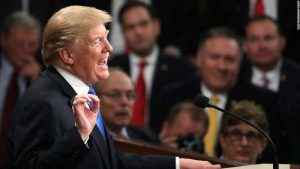JANUARY 24, 2019
 In the hours after House Speaker Nancy Pelosi’s letter announcing she would not allow President Donald Trump to speak from the room she now controls, a flurry of suggestions and proposals emerged from Trump’s advisers.
In the hours after House Speaker Nancy Pelosi’s letter announcing she would not allow President Donald Trump to speak from the room she now controls, a flurry of suggestions and proposals emerged from Trump’s advisers.
What about a speech on the US-Mexico border? Or an address at Philadelphia’s Independence Hall, where the Constitution was adopted? Or a stately affair inside the White House, with an audience of Republicans?
No, Trump decided.
In the end, all those suggestions for an “alternate” State of the Union address were too narrow, too bland and too small. Instead, the President told them, he would wait for the only venue he really wanted for the annual speech: the US House.
While aides have still not ruled out some type of event next week to drive his message on border security and a wall, they have taken his direction and will not plan for a State of the Union address at any venue that isn’t the House chamber.
Trump may still travel south to campaign for a wall, officials said it would not be billed as a State of the Union nor would it seek to fulfill the constitutional requirement to periodically update Congress on the country’s condition.
Caught off-guard
Trump and his aides felt they were calling Pelosi’s bluff through the letter sent on Wednesday declaring no security threat to the speech that would prevent him from speaking. Most inside the White House did not believe the speaker would essentially disinvite Trump by refusing a vote on a resolution that would allow him to deliver the address from the House. And they were caught off guard when she followed through.
Other options the President’s aides suggested included Independence Hall in Philadelphia, where the Declaration of Independence and the US Constitution were adopted; a campaign rally in Trump country; or the US Senate, which would not require Pelosi’s permission but would still require a 60-vote resolution that aides weren’t sure would pass.
Aides had also begun scoping out areas of the White House where an address could be delivered. Led by communications chief Bill Shine, advisers went on a walk-through of various locations to search for a room and camera shot that could lend the address a presidential bearing, including the East Room with the red-carpeted Cross Hall in the background.
Yet after going back-and-forth with aides into the evening, Trump finally decided himself it was time to put the matter to rest.
“I will do the Address when the Shutdown is over,” he tweeted late in the night. “I am not looking for an alternative venue for the SOTU Address because there is no venue that can compete with the history, tradition and importance of the House Chamber.”
No good alternative
Trump was not enthusiastic about the options his team presented for alternate venues, according to officials familiar with the matter, believing they could not replicate the look and feel of a traditional address to a Joint Session of Congress. Trump, who regularly expresses his joy at the trappings of his job, told confidants he did not want anything less grand than the frescoed US Capitol.
“If we can handle Iraq, we can handle the middle of Washington in a very, very spectacular building, and a beautiful room that we should be in, and that’s where it’s been for a very long time,” he said Wednesday, downplaying security concerns about a State of the Union during the government shutdown.
Trump also expressed frustration at having to travel outside of Washington to deliver a speech he felt entitled to deliver in the Capitol.
Each alternative also posed several logistical and optics problems, particularly as many White House advance and logistics staffers remained furloughed amid the extended government shutdown. The President was also not keen to deliver a State of the Union address with Republicans only — or mostly — in the audience, which would likely be the case if they chose the Senate chamber or a room at the White House.
White House officials said they were hesitant to hold a campaign-style rally because they realized it was not formal enough to look like the traditional speech. And there was a recognition it’s harder to keep Trump on message during a rally, where he often feeds off the crowd, versus a more formal address. Officials also noted that television networks rarely carry the rallies live.
Also fueling the uncertainty over an alternate venue: some aides believed a speech delivered in an alternative venue on Tuesday might allow Pelosi to rescind her invitation altogether, arguing Trump had already technically given it. That was something still being debated when Trump ultimately caved, telling Pelosi he will wait until the shutdown is over to deliver the traditional address.
Courtesy/Source: CNN










































































































